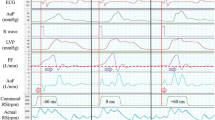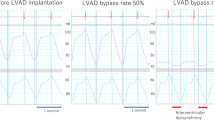Abstract
There are many reports comparing pulsatile and continuous-flow left ventricular assist devices (LVAD). But continuous-flow LVAD with the pulsatile driving technique had not been tried or discussed before our group’s report. We have previously developed and introduced a power-control unit for a centrifugal LVAD (EVAHEART®; Sun Medical), which can change the speed of rotation so it is synchronized with the heart beat. By use of this unit we analyzed the end-diastolic volume (EDV) to determine whether it is possible to change the native heart load. We studied 5 goats with normal hearts and 5 goats with acute LV dysfunction because of micro-embolization of the coronary artery. We used 4 modes, “circuit-clamp”, “continuous”, “counter-pulse”, and “co-pulse”, with the bypass rate (BR) 100%. We raised the speed of rotation of the LVAD in the diastolic phase with the counter-pulse mode, and raised it in the systolic phase with the co-pulse mode. As a result, the EDV decreased in the counter-pulse mode and increased in the co-pulse mode, compared with the continuous mode (p < 0.05), in both the normal and acute-heart-failure models. This result means it may be possible to achieve favorable EDV and native heart load by controlling the rotation of continuous-flow LVAD, so it is synchronized with the cardiac beat. This novel driving system may be of great benefit to patients with end-stage heart failure, especially those with ischemic etiology.




Similar content being viewed by others
References
Potapov EV, Loebe M, Abdul-Khaliq H, Koster A, Stein J, Sodian R, Kopitz M, Hausmann H, Noon GP, DeBakey ME, Hetzer R. Postoperative course of S-100B protein and neuron-specific enolase in patients after implantation of continuous and pulsatile flow LVADs. J Heart Lung Transplant. 2001;20:1310–6.
Zimpfer D, Wieselthaler G, Czerny M, Fakin R, Haider D, Zrunek P, Roethy W, Schima H, Wolner E, Grimm M. Neurocognitive function in patients with ventricular assist devices: a comparison of pulsatile and continuous blood flow devices. ASAIO J. 2006;52:24–7.
Koenig SC, Pantalos GM, Gillars KJ, Ewert DL, Litwak KN, Etoch SW. Hemodynamic and pressure–volume responses to continuous and pulsatile ventricular assist in an adult mock circulation. ASAIO J. 2004;50:15–24.
Garatti A, Bruschi G, Colombo T, Russo C, Lanfranconi M, Milazzo F, Frigerio M, Vitali E. Clinical outcome and bridge to transplant rate of left ventricular assist device recipient patients: comparison between continuous-flow and pulsatile-flow devices. Eur J Cardiothorac Surg. 2008;34:275–80. discussion 280. Epub 2008 Mar 28.
Yamazaki K, Kihara S, Akimoto T, Tagusari O, Kawai A, Umezu M, Tomioka J, Kormos RL, Griffith BP, Kurosawa H. EVAHEART: an implantable centrifugal blood pump for long-term circulatory support. J Thorac Cardiovasc Surg. 2002;50:461–5.
Yamazaki K, Saito S, Kihara S, Tagusari O, Kurosawa H. Completely pulsatile high flow circulatory support with a constant-speed centrifugal blood pump: mechanisms and early clinical observations. Thorac Cardiovasc Surg. 2007;55:158–62.
Ando M, Nishimura T, Takewa Y, Yamazaki K, Kyo S, Ono M, Tsukiya T, Mizuno T, Taenaka Y, Tatsumi E. Electrocardiogram-synchronized rotational speed change mode in rotary pumps could improve pulsatility. Artif Organs. 2011;35:941–7.
Ando M, Takewa Y, Nishimura T, Yamazaki K, Kyo S, Ono M, Tsukiya T, Mizuno T, Taenaka Y, Tatsumi E. A novel counterpulsation mode of rotary left ventricular assist devices can enhance myocardial perfusion. J Artif Organs. 2011;14:185–91.
Klocke R, Tian W, Kuhlmann MT, Nikol S. Surgical animal models of heart failure related to coronary heart disease. Cardiovasc Res. 2007;74:29–38.
Dixon JA, Spinale FG. Large animal models of heart failure: a critical link in the translation of basic science to clinical practice. Circ Heart Fail. 2009;2:262–71.
Gill RM, Jones BD, Corbly AK, Wang J, Braz JC, Sandusky GE, Wang J, Shen W. Cardiac diastolic dysfunction in conscious dogs with heart failure induced by chronic coronary microembolization. Am J Physiol Heart Circ Physiol. 2006;291:H3154–8.
Ando M, Nishimura T, Takewa Y, Ogawa D, Yamazaki K, Kashiwa K, Kyo S, Ono M, Taenaka Y, Tatsumi E. What is the ideal off-test trial for continuous-flow ventricular-assist-device explantation? Intracircuit back-flow analysis in a mock circulation model. J Artif Organs. 2011;14:70–3.
Ando M, Nishimura T, Takewa Y, Ogawa D, Yamazaki K, Kashiwa K, Kyo S, Ono M, Taenaka Y, Tatsumi E. A novel counterpulse drive mode of continuous-flow left ventricular assist devices can minimize intracircuit backward flow during pump weaning. J Artif Organs. 2011;14:74–9.
Suga H. Total mechanical energy of a ventricle model and cardiac oxygen consumption. Am J Physiol. 1979;236:H498–505.
Suga H, Igarashi Y, Yamada O, Goto Y. Cardiac oxygen consumption and systolic pressure volume area. Basic Res Cardiol. 1986;81:39–50.
Suga H, Hisano R, Goto Y, Yamada O, Igarashi Y. Effect of positive inotropic agents on the relation between oxygen consumption and systolic pressure volume area in canine left ventricle. Circ Res. 1983;53:306–18.
Topilsky Y, Oh JK, Atchison FW, Shah DK, Bichara VM, Schirger JA, Kushwaha SS, Pereira NL, Park SJ. Echocardiographic findings in stable outpatients with properly functioning HeartMate II left ventricular assist devices. J Am Soc Echocardiogr. 2011;24:157–69.
Maybaum S, Mancini D, Xydas S, Starling RC, Aaronson K, Pagani FD, Miller LW, Margulies K, McRee S, Frazier OH, Torre-Amione G, LVAD Working Group. Cardiac improvement during mechanical circulatory support: a prospective multicenter study of the LVAD Working Group. Circulation. 2007;115:2497–505.
McConnell PI, Del Rio CL, Kwiatkowski P, Farrar DJ, Sun BC. Assessment of cardiac function during axial-flow left ventricular assist device support using a left ventricular pressure-derived relationship: comparison with pre-load recruitable stroke work. J Heart Lung Transplant. 2007;26:159–66.
Drakos SG, Kfoury AG, Selzman CH, Verma DR, Nanas JN, Li DY, Stehlik J. Left ventricular assist device unloading effects on myocardial structure and function: current status of the field and call for action. Curr Opin Cardiol. 2011;26:245–55.
Author information
Authors and Affiliations
Corresponding authors
Rights and permissions
About this article
Cite this article
Umeki, A., Nishimura, T., Ando, M. et al. Alteration of LV end-diastolic volume by controlling the power of the continuous-flow LVAD, so it is synchronized with cardiac beat: development of a native heart load control system (NHLCS). J Artif Organs 15, 128–133 (2012). https://doi.org/10.1007/s10047-011-0615-3
Received:
Accepted:
Published:
Issue Date:
DOI: https://doi.org/10.1007/s10047-011-0615-3




